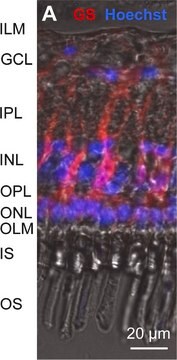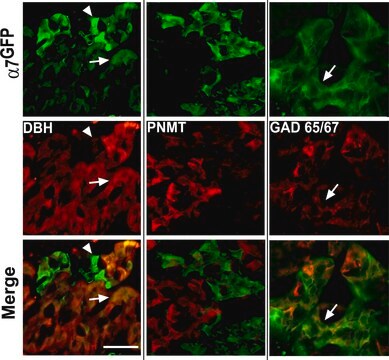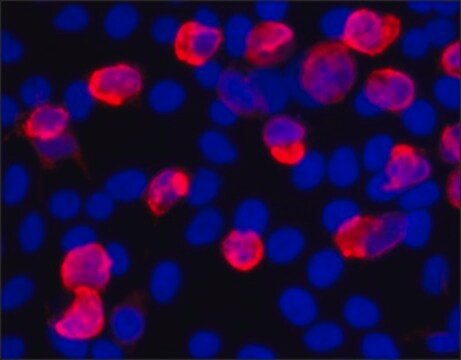추천 제품
생물학적 소스
rabbit
Quality Level
결합
unconjugated
항체 형태
IgG fraction of antiserum
항체 생산 유형
primary antibodies
클론
polyclonal
형태
buffered aqueous solution
분자량
antigen 45 kDa
종 반응성
rat
포장
antibody small pack of 25 μL
기술
immunohistochemistry (formalin-fixed, paraffin-embedded sections): 1:10,000 using rat brain sections
microarray: suitable
western blot: 1:10,000 using rat brain cytosolic fraction
UniProt 수납 번호
저장 온도
−20°C
타겟 번역 후 변형
unmodified
유전자 정보
human ... GLUL(2752)
mouse ... Glul(14645)
rat ... Glul(24957)
일반 설명
Anti-Glutamine Synthetase is produced in rabbit using a synthetic peptide corresponding to the C-terminus of mouse glutamine synthetase (GS) conjugated to keyhole limpet hemocyanin (KLH) as immunogen. This sequence is identical in human, bovine, rat, hamster and pig GS, and highly conserved in chicken GS. GS is found in mammals as an octamer of identical 45 kDa subunits. It is localized in glial cells of various species. It is present in the brain primarily in astrocytes and in the retina in Muller glial cells that support neurons using glutamate as a neurotransmitter. GS is found in several brain regions including hippocampus, cerebral cortex, neostriatum and cerebellar granular layer, corresponding to sites with high glutamate receptor density.
특이성
Anti-Glutamine synthetase recognizes rat glutamine synthetase (GS) (45 kDa). Staining of GS in immunoblotting is specifically inhibited with the GS immunizing peptide (amino acids 357-373 with Nterminally added lysine).
면역원
synthetic peptide corresponding to the C-terminal region of mouse glutamine synthetase (GS) (amino acids 357-373. This sequence is identical in human, bovine, rat, hamster, and pig GS and highly conserved chicken
Gs (single amino acid substitution).
Gs (single amino acid substitution).
애플리케이션
Immunoblotting: a minimum working antibody dilution of 1:10,000 is determined using a rat brain cytosolic fraction extract.
Immunohistochemistry: a minimum working antibody dilution of 1:10,000 is determined using formalin-fixed, paraffin-embedded sections of rat brain.
Anti-Glutamine Synthetase antibody has been used for the detection and localization of GS by immunoblotting and immunohistochemistry.
생화학적/생리학적 작용
Glutamine synthetase (GS) catalyzes the amidation of glutamate to form glutamine. In the brain, GS is considered as a key enzyme, participating in recycling of the excitatory neurotransmitter glutamate released from neurons and termination of the neurotransmitter signal, as well as in ammonia detoxification. GS activity is a useful marker for astrocytes and an important differentiation feature in the retina. Upregulation of GS is a hallmark of reactive astrocytosis and GS activity level increases following spinal cord injury. The GS expression in astrocytes is diminished in brains affected by Alzheimer′s disease, particularly in the vicinity of senile plaques. GS is upregulated in a subset of human hepatocellular carcinomas, suggesting that its expression may be related to tumor recurrence, since tumors expressing GS are independent of the extracellular glutamine supply.
물리적 형태
Solution in 0.01 M phosphate buffered saline, pH 7.4, containing 15 mM sodium azide
면책조항
Unless otherwise stated in our catalog or other company documentation accompanying the product(s), our products are intended for research use only and are not to be used for any other purpose, which includes but is not limited to, unauthorized commercial uses, in vitro diagnostic uses, ex vivo or in vivo therapeutic uses or any type of consumption or application to humans or animals.
적합한 제품을 찾을 수 없으신가요?
당사의 제품 선택기 도구.을(를) 시도해 보세요.
Storage Class Code
12 - Non Combustible Liquids
WGK
WGK 2
Flash Point (°F)
Not applicable
Flash Point (°C)
Not applicable
시험 성적서(COA)
제품의 로트/배치 번호를 입력하여 시험 성적서(COA)을 검색하십시오. 로트 및 배치 번호는 제품 라벨에 있는 ‘로트’ 또는 ‘배치’라는 용어 뒤에서 찾을 수 있습니다.
이미 열람한 고객
Effects of bevacizumab (Avastin) on retinal cells in organotypic culture
Kaempf S, et al.
Investigative Ophthalmology & Visual Science, 49(7), 3164-3171 (2008)
Deniz Dalkara et al.
Molecular therapy : the journal of the American Society of Gene Therapy, 19(9), 1602-1608 (2011-04-28)
Mutations in over 80 identified genes can induce apoptosis in photoreceptors, resulting in blindness with a prevalence of 1 in 3,000 individuals. This broad genetic heterogeneity of disease impacting a wide range of photoreceptor functions renders the design of gene-specific
Ying Zhu et al.
mBio, 8(4) (2017-08-16)
While glutamine is a nonessential amino acid that can be synthesized from glucose, some cancer cells primarily depend on glutamine for their growth, proliferation, and survival. Numerous types of cancer also depend on asparagine for cell proliferation. The underlying mechanisms
Peter X Shaw et al.
Investigative ophthalmology & visual science, 57(11), 5083-5092 (2016-09-30)
We have previously demonstrated that soluble adenylyl cyclase (sAC) is necessary for retinal ganglion cell (RGC) survival and axon growth. Here, we further investigate the role of sAC in neuronal differentiation during retinal development. Chx10 or Math5 promoter-driven Cre-Lox recombination
Ala Moshiri et al.
Investigative ophthalmology & visual science, 58(3), 1709-1718 (2017-03-23)
Small guanosine triphosphatase (GTPase) ADP-ribosylation factors (Arfs) regulate membrane traffic and actin reorganization under the control of GTPase-activating proteins (GAPs). Arap1 is an Arf-directed GAP that inhibits the trafficking of epidermal growth factor receptor (EGFR) to the early endosome, but
자사의 과학자팀은 생명 과학, 재료 과학, 화학 합성, 크로마토그래피, 분석 및 기타 많은 영역을 포함한 모든 과학 분야에 경험이 있습니다..
고객지원팀으로 연락바랍니다.











